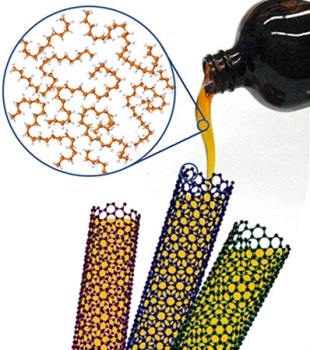Jul 19 2016
Researchers who are trying to use the unique properties of carbon nanotubes often give up hope when the small cylinders fill with water during processing.
 To prevent cores of single-wall carbon nanotubes from filling with water or other detrimental substances, the NIST researchers advise intentionally prefilling them with a desired chemical of known properties. Taking this step before separating and dispersing the materials, usually done in water, yields a consistently uniform collection of nanotubes, especially important for optical applications.(Credit: Fagan/NIST)
To prevent cores of single-wall carbon nanotubes from filling with water or other detrimental substances, the NIST researchers advise intentionally prefilling them with a desired chemical of known properties. Taking this step before separating and dispersing the materials, usually done in water, yields a consistently uniform collection of nanotubes, especially important for optical applications.(Credit: Fagan/NIST)
However for nanotube practitioners who have given up, the National Institute of Standards and Technology (NIST) have devised a cost-effective, rapid and efficient approach that can certainly improve the consistency and quality of the materials, which are effectively used in applications such as new computing technologies.
The NIST researchers recommend intentionally prefilling these nanotubes with a suitable chemical of known properties to help prevent filling of the cores of single-wall carbon nanotubes with other detrimental substances or water. Performing this step prior to dispersing and separating the materials, which is commonly done using water, provides a collection of nanotubes that are uniform and constant. The results in terms of quality and quantity are superior when compared to water-filled nanotubes particularly for optical applications such as photodetectors and sensors.
This strategy is a simple method used for controlling the properties of single-wall carbon nanotubes that are carbon atoms rolled up into sheets and arranged in the form of chicken wire or honey combs with new or improved properties.
This approach is so easy, inexpensive and broadly useful that I can’t think of a reason not to use it.
Jeffrey Fagan, Chemical Engineer, NIST
The NIST team in their proof-of-concept experiments, placed over 20 unique compounds into a variety of single-wall carbon nanotubes with an interior diameter ranging more than 2 down to about 0.5 nanometers. Together with visiting researcher Jochen Campo who headed the research, the scientists analyzed their method using hydrocarbons called alkanes as fillers.
The alkanes include standard compounds such as butane and propane, and they rendered nanotube interiors unreactive. Nanotubes filled with these alkanes reacted like they were empty, which was the aim of Fagan, Campo and colleagues.
Empty nanotubes have better properties compared to nanotubes filled with ions and water, acids and other unwanted chemicals encountered during processing. Empty nanotubes for example, emit brighter and sharper signals when stimulated by light.
The NIST team’s recent article featured in Nanoscale Horizons highlighted that the process of “spontaneous ingestion” of water or other solvents by the nanotubes is an “endemic but often neglected phenomenon with strong implications for the development of nanotube applications.”
Researchers accept mixed batches of empty or unfilled and majorly filled single-wall carbon nanotubes because filtering and gathering nanotubes is expensive and requires a lot of effort. Campo's estimations point out that removing empty nanotubes from these mixtures require using expensive ultracentrifuge equipment that yields only 10%.
If your goal is to use nanotubes for electronic circuits, for example, or for fluorescent anti-cancer image contrast agents, then you require much greater quantities of materials of consistent composition and quality. This particular need inspired development of the new prefilling method by asking the question, can we put some passive chemical into the nanotube instead to keep the water out.
Jochen Campo, Researcher, University of Antwerp
Answers for these experiments were positive from the beginning and the benefits were significant. In fluorescence experiments, nanotubes filled with alkanes emitted signals much stronger when compared to those emitted by water-filled nanotubes. The performance approach of these empty nanotubes sets the gold standard for these comparisons.
According to the researchers this prefilling method developed by NIST is flexible, controllable and can be easily implemented into existing methods for managing single-wall carbon nanotubes.